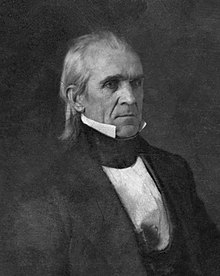|
United States of America
James Polk – Eleventh President
1970 Proof Silver Medal 39mm (32.98 grams) 0.925 Silver
JAMES POLK 1845 ELEVENTH PRESIDENT OF THE UNITED STATES 1849, James facing 3/4 right.
JAMES KNOX POLK BORN NOV. 2, 1795. MARRIED SARAH CHILDRESS, 1824. FIRST “DARK HORSE” PRESIDENT; EXTENDED US.S. BORDERS TO THE 49TH PARALLEL, TO THE RIO GRANDE AND TO THE PACIFIC OCEAN. DIED JUNE 15, 1849., Eagle with arrows in claws right atop American shield with stripes and stars.
You are bidding on the exact item pictured, provided with a Certificate of Authenticity and Lifetime Guarantee of Authenticity.

James Knox Polk (November 2, 1795 – June 15, 1849) was the 11th president of the United States, serving from 1845 to 1849. He previously was the 13th speaker of the House of Representatives (1835–1839) and ninth governor of Tennessee (1839–1841). A protégé of Andrew Jackson, he was a member of the Democratic Party and an advocate of Jacksonian democracy. Polk is chiefly known for extending the territory of the United States through the Mexican–American War; during his presidency, the United States expanded significantly with the annexation of the Republic of Texas, the Oregon Territory, and the Mexican Cession following American victory in the Mexican–American War.
After building a successful law practice in Tennessee, Polk was elected to its state legislature in 1823 and then to the United States House of Representatives in 1825, becoming a strong supporter of Andrew Jackson. After serving as chairman of the Ways and Means Committee, he became Speaker of the House in 1835, the only person to have served both as Speaker and U.S. president. Polk left Congress to run for governor of Tennessee, winning in 1839 but losing in 1841 and 1843. He was a dark horse candidate in the 1844 presidential election as the Democratic Party nominee; he entered his party’s convention as a potential nominee for vice president but emerged as a compromise to head the ticket when no presidential candidate could secure the necessary two-thirds majority. In the general election, Polk defeated Henry Clay of the rival Whig Party.
Historians have praised Polk for meeting every major domestic and foreign policy goal he had set during his single term. After a negotiation fraught with the risk of war, he reached a settlement with Great Britain over the disputed Oregon Country, the territory, for the most part, being divided along the 49th parallel. He provoked a war with Mexico in an attempt to expand the United States and succeeded in doing so, as it resulted in Mexico’s cession of nearly all the American Southwest. He secured a substantial reduction of tariff rates with the Walker tariff of 1846. The same year, he achieved his other major goal, re-establishment of the Independent Treasury system. True to his campaign pledge to serve only one term, Polk left office in 1849 and returned to Tennessee, where he died three months after leaving the White House.
Though he is relatively obscure today, scholars have ranked Polk favorably for his ability to promote and achieve the major items on his presidential agenda, despite limiting himself to a single term. He has also been criticized for leading the country into an aggressive war against Mexico and thus exacerbating divides between free and slave states. A property owner who used slave labor for most of his adult life, he kept a plantation in Mississippi and increased his slave ownership during his presidency. The legacy of Polk’s policy of territorial expansion – with the United States reaching the Pacific coast and, roughly, its present contiguous borders – made the United States a nation poised to become a world power, but with sectional divisions gravely exacerbated, setting the stage for the Civil War.
|











